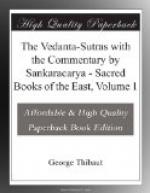[Footnote 222: The li@nga contained in the word ‘Sudra’ has no proving power as it occurs in an arthavada-passage which has no authority if not connected with a corresponding injunctive passage. In our case the li@nga in the arthavada-passage is even directly contradicted by those injunctions which militate against the Sudras’ qualification for Vedic matters.]
[Footnote 223: Ha/m/savakyad atmanoznadara/m/ srutva jana/s/rute/h/ sug utpannety etad eva katha/m/ gamyate yenasau sudra/s/abdena sa/k/yate tatraha sp/ris/yate keti. Ananda Giri.]
[Footnote 224: I translate this passage as I find it in all MSS. of Sa@nkara consulted by me (noting, however, that some MSS. read kaitrarathinamaika/h/). Ananda Giri expressly explains tasmad by kaitrarathad ity artha/h/.—The text of the Ta/nd/ya Br. runs: tasma/k/ kaitrarathinam eka/h/ kshatrapatir gayate, and the commentary explains: tasmat kara/n/ad adyapi kitrava/ms/otpannana/m/ madhye eka eva raja kshatrapatir baladhipatir bhavati.—Grammar does not authorise the form kahraratha used in the Sutra.]
[Footnote 225: The king A/s/vapati receives some Brahma/n/as as his pupils without insisting on the upanayana. This express statement of the upanayana having been omitted in a certain case shows it to be the general rule.]
[Footnote 226: As the words stand in the original they might be translated as follows (and are so translated by the purvapakshin), ’Whatever there is, the whole world trembles in the pra/n/a, there goes forth (from it) a great terror, viz. the raised thunderbolt.’]
[Footnote 227: The stress lies here on the ‘as if.’ which intimate that the Self does not really think or move.]
FOURTH PADA.
REVERENCE TO THE HIGHEST SELF!
1. If it be said that some (mention) that which is based on inference (i.e. the pradhana); we deny this, because (the term alluded to) refers to what is contained in the simile of the body (i.e. the body itself); and (that the text) shows.
In the preceding part of this work—as whose topic there has been set forth an enquiry into Brahman—we have at first defined Brahman (I, 1, 2); we have thereupon refuted the objection that that definition applies to the pradhana also, by showing that there is no scriptural authority for the latter (I, 1, 5), and we have shown in detail that the common purport of all Vedanta-texts is to set forth the doctrine that Brahman, and not the pradha/n/a, is the cause of the world. Here, however, the Sa@nkhya again raises an objection which he considers not to have been finally disposed of.




